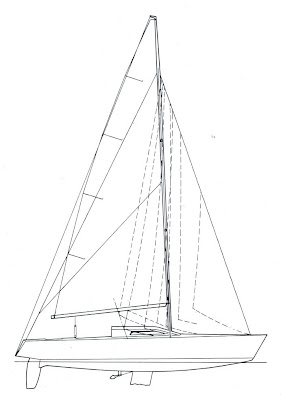 The Red Lion was commissioned by NZ sailor Stu Brentnall who was keen to have another crack at the One Ton Cup after his efforts with Jiminy Cricket in the 1976 series held in Marseilles. The yacht was one of a number of new centreboarders to emerge from the board of Bruce Farr in 1977, and she joined sisterships Jenny H, Smir-Noff-Agen and Mr Jumpa for the New Zealand One Ton Cup trials, for the regatta held in Auckland later that year.
The Red Lion was commissioned by NZ sailor Stu Brentnall who was keen to have another crack at the One Ton Cup after his efforts with Jiminy Cricket in the 1976 series held in Marseilles. The yacht was one of a number of new centreboarders to emerge from the board of Bruce Farr in 1977, and she joined sisterships Jenny H, Smir-Noff-Agen and Mr Jumpa for the New Zealand One Ton Cup trials, for the regatta held in Auckland later that year.  These new generation One Tonners were a significant development of Farr's earlier keelboats from 1975/76 - after the rulemakers failed to close the centreboard loophole exposed to great effect by the Britton Chance design Resolute Salmon in 1976, a centreboard was used for the new boats, although the fins on the Farr yachts weighed about 360kg, despite the fact that this was discouraged by the IOR. The need for a large amount of internal ballast meant that a higher displacement was necessary to achieve a higher ballast ratio, but this in turn allowed for more sail area, and better light air performance.
These new generation One Tonners were a significant development of Farr's earlier keelboats from 1975/76 - after the rulemakers failed to close the centreboard loophole exposed to great effect by the Britton Chance design Resolute Salmon in 1976, a centreboard was used for the new boats, although the fins on the Farr yachts weighed about 360kg, despite the fact that this was discouraged by the IOR. The need for a large amount of internal ballast meant that a higher displacement was necessary to achieve a higher ballast ratio, but this in turn allowed for more sail area, and better light air performance. Although narrower in the stern than their 1976 counterparts, clever design of the after girth stations allowed for undistorted stern sections and a more upright transom. The design was able to reach high speeds very easily, and they were particularly fast in reaching conditions.
 |
| The Red Lion shows the clean and narrower stern shape of the 1977 generation of Farr One Tonners |
 |
| The sharp end of The Red Lion |
The centreboarders took out the top places and thus filled all the places for the New Zealand team, with Smackwater Jack taking out overall honours (some of the out-moded keelboats went on to compete in the Cup proper as overseas charter entries). The Red Lion failed to fire in the trials, but nevertheless qualified for the team with a fifth placing. She also competed soon afterwards in the Southern Cross Cup trials, but missed out, finishing behind the Half Tonner Swuzzelebubble, Smir-Noff-Agen and Jenny H.
 |
| The Red Lion during the 1977 One Ton Cup and sporting her new Ross&Jones mainsail |
 |
| The Red Lion in light airs during the start of the middle distance race of the 1977 One Ton Cup |
 |
| Spinnaker and shooter set on a downwind leg in the 1977 One Ton Cup |
 |
| The Red Lion powers upwind during the 1977 One Ton Cup series |
 |
| The Red Lion under her new Italian ownership at the 1978 One Ton Cup |



No comments:
Post a Comment